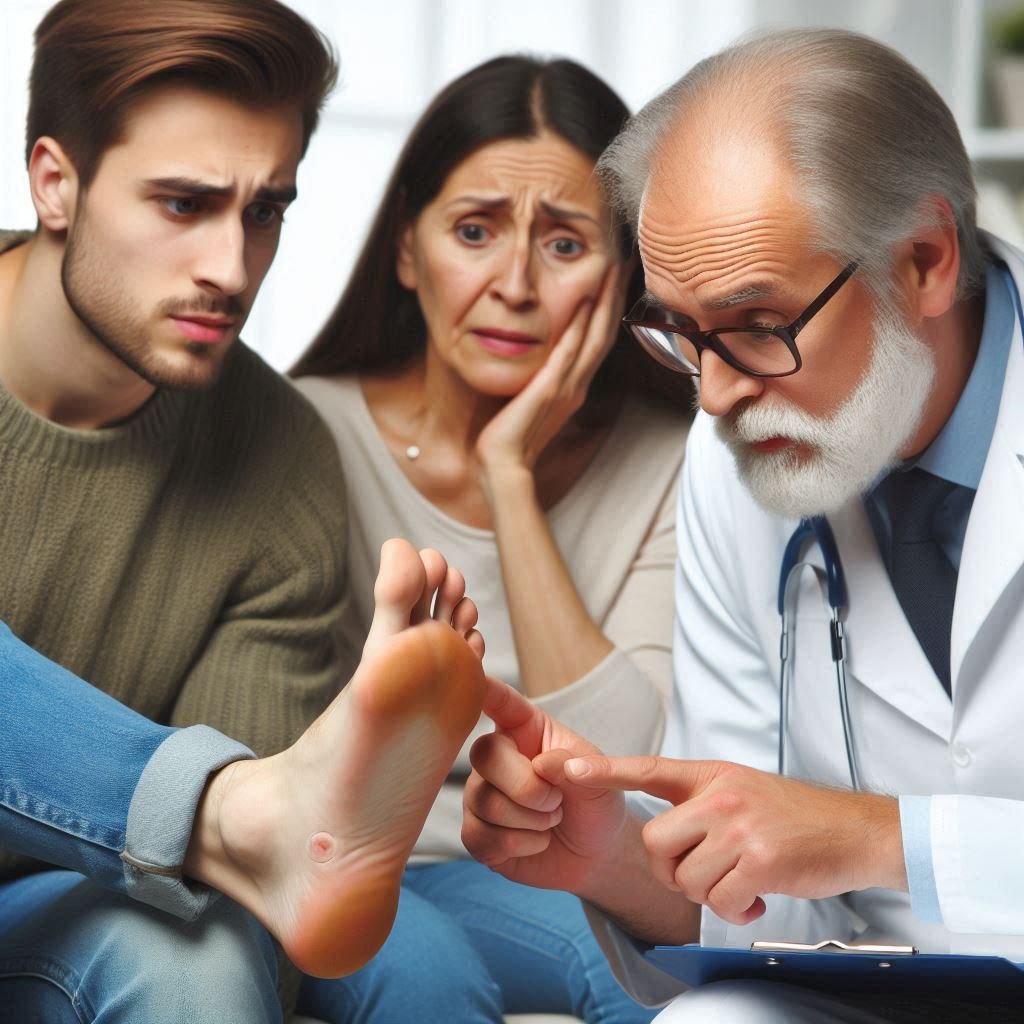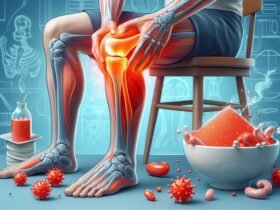Table of Contents
Foot Bumps on side of your foot can be annoying and sometimes painful. They can come from different causes, some common and others not so much. Knowing why these bumps appear and how to treat them is important to keep your feet healthy and pain-free. This article will help you understand the various reasons behind foot bumps and the best ways to deal with them.
Key Takeaways
Common Causes of Foot Bumps on the Side
Foot bumps on the side can be caused by various conditions. Here are some of the most common ones:
Bunions and Tailor’s Bunions
Bunions and tailor’s bunions are bony bumps that form on the joint at the base of your big toe or little toe. These bumps often result from an abnormal shape of the bone and joints in the foot. They can cause pain, especially when shoes rub against them. Wearing wider shoes and using pads can help, but in severe cases, surgery might be needed.
Ganglion Cysts
Ganglion cysts are small, fluid-filled sacs that develop just below the skin. They are usually found on the side or top of the foot. These cysts are generally not painful unless they press on a nerve or rub against your shoes. Treatment options include medication, splinting, aspiration, or surgery if the cysts become painful or affect daily activities.
Corns and Calluses
Corns and calluses are thickened layers of skin that develop due to friction or pressure. They often form on the sides of the feet and can be painful. Proper footwear and protective pads can help alleviate the discomfort. In some cases, a doctor may need to trim away the thickened skin.
Bone Spurs
Bone spurs are bony projections that develop along the edges of bones. They can form on the side of the foot and cause pain when they press against soft tissues or other bones. Treatment may include physical therapy, medications, or in severe cases, surgery to remove the spurs.
Rare Causes of Foot Bumps on the Side
Bursitis
Bursitis is the inflammation of small fluid-filled sacs called bursae. These sacs help reduce friction between bones and soft tissues. When they become inflamed, it can cause a painful bump on the side of the foot. Heel bursitis is the most common type.
Cuboid Syndrome
Cuboid Syndrome happens when the cuboid bone gets dislocated. This can lead to a small, hard lump on the side of the foot. If you have ongoing pain on the outer side of your foot after an ankle sprain, there’s a high chance it’s cuboid syndrome.
Lipomas
Lipomas are soft, fatty lumps that grow under the skin. They are usually found on the top of the foot but can also appear on the side. These lumps are generally harmless and painless.
Rheumatoid Nodules
If you have rheumatoid arthritis, you might develop rheumatoid nodules. These are firm lumps caused by a build-up of inflammatory particles. They often form on the side of the foot and can be quite painful.
It’s important to have any new lumps on your foot checked by a doctor, especially if they are large, fast-growing, or painful.
Diagnosing Foot Bumps on the Side

Physical Examination
The first step in diagnosing foot bumps is a physical examination. Your doctor will look at the bump and ask about your symptoms. They might press on the bump to see if it hurts or if it feels soft or hard. This helps them figure out what might be causing the bump.
Imaging Techniques
Sometimes, doctors need to see inside your foot to understand the problem better. They might use imaging techniques like X-rays, MRIs, or ultrasounds. These tools can show if there are issues with your bones, muscles, or other tissues. For example, an X-ray can reveal if a bone spur is causing the bump.
Biopsy and Lab Tests
In some cases, doctors need to take a small sample of the bump to study it more closely. This is called a biopsy. They might also do lab tests to check for infections or other conditions. This step is important if the bump is unusual or if other tests don’t give clear answers.
It’s crucial to get a proper diagnosis to ensure you receive the right treatment. Don’t ignore foot bumps, especially if they are painful or growing.
Remember, diagnosing foot bumps early can help prevent more serious problems later on.
Treatment Options for Foot Bumps on the Side

Non-Surgical Treatments
For many foot bumps, non-surgical treatments can be very effective. Wearing wider shoes can help reduce pressure on the bump. Pads or cushions can also be placed over or around the area to provide relief. In some cases, the bump can be drained if it is filled with fluid. Topical treatments like roseberry oil or agave plant nectar may also provide some relief.
Surgical Treatments
When non-surgical methods don’t work, surgery might be needed. The type of surgery will depend on the cause of the bump. For example, bunions might require bone realignment, while cysts may need to be removed. After surgery, you might need to wear a protective boot or cast to help your foot heal.
Home Remedies
There are several home remedies that can help manage foot bumps. Soaking your feet in warm water can soften the skin and reduce discomfort. Applying ice packs can help reduce swelling. Over-the-counter pain relievers can also be useful. Some people find relief using natural treatments like roseberry oil or agave plant nectar.
When to See a Doctor
If your foot bump is causing severe pain, limiting your ability to walk, or not improving with home treatments, it’s time to see a doctor. A healthcare professional can identify the cause of the bump and recommend the best treatment options. Remember, our podiatrists can identify and treat your lumps and bumps effectively.
Preventing Foot Bumps on the Side
Proper Footwear
Wearing the right shoes is crucial. Proper, well-fitting footwear can prevent many foot problems. Avoid tight shoes like high heels and opt for comfortable ones. Break in new shoes before long activities to avoid blisters.
Foot Hygiene
Keeping your feet clean and dry is essential. Use a drying agent and wear socks to keep feet dry. Regularly check your feet for any signs of issues and address them promptly.
Regular Check-Ups
Visit a podiatrist regularly to catch any potential problems early. Self-diagnosing foot conditions can be tricky, so it’s best to consult a professional.
Weight Management
Maintaining a healthy weight reduces the stress on your feet. A balanced diet and regular exercise can help you manage your weight effectively.
Taking care of your feet can prevent many issues and keep you active and pain-free.
Living with Foot Bumps on the Side

Pain Management
Living with foot bumps on the side can be uncomfortable. Pain management is crucial. Over-the-counter pain relievers like ibuprofen can help. Sometimes, doctors may suggest stronger medications. Ice packs can also reduce swelling and pain.
Lifestyle Adjustments
Making small changes in your daily routine can make a big difference. Avoid activities that put too much pressure on your feet. If you enjoy tattoos and piercings, make sure they don’t irritate the bumps. Opt for low-impact exercises like swimming or cycling.
Supportive Footwear
Wearing the right shoes is essential. Choose shoes with good arch support and a wide toe box. Avoid high heels and tight shoes. Custom orthotics can also provide extra support and comfort.
Conclusion of foot bumps on side of your foot.
Foot bumps on the side can be caused by many different things, from bunions and cysts to tendonitis and more. It’s important to get any new or painful bumps checked out by a doctor to find out what’s causing them and to get the right treatment. Wearing comfortable shoes, keeping an eye on your feet, and seeing a specialist when needed can help keep your feet healthy. Remember, early treatment can make a big difference, so don’t wait to get help if you notice something unusual on your foot.
Frequently Asked Questions
What causes bumps on the side of my foot?
Bumps on the side of your foot can be caused by various factors including bunions, ganglion cysts, corns, calluses, and bone spurs. Less common causes include bursitis, lipomas, and rheumatoid nodules.
Are foot bumps always painful?
Not always. Some foot bumps, like ganglion cysts, may be painless unless they press against a nerve or rub against shoes. Others, like bunions and corns, can be painful especially when irritated.
How are foot bumps diagnosed?
Doctors usually start with a physical examination. They might also use imaging techniques like X-rays or MRIs. In some cases, a biopsy or lab tests may be needed to identify the cause.
Can foot bumps go away on their own?
Some foot bumps, like ganglion cysts, may go away on their own. However, most bumps require some form of treatment, especially if they cause pain or interfere with daily activities.
What are the treatment options for foot bumps?
Treatment can range from non-surgical methods like wearing proper footwear and using pads, to surgical options for more severe cases. Home remedies and physical therapy can also help.
How can I prevent foot bumps?
Wearing well-fitting shoes, maintaining good foot hygiene, regular check-ups, and managing your weight can help prevent foot bumps. Stretching and taking care of your feet after physical activities are also beneficial.














Leave a Review